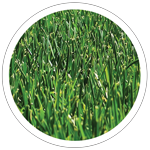THE BLENDS

Chesaks Town Mix
60% Kentucky Bluegrass
10% Creeping Red Fescue
30% Periennial Ryegrass
Chesaks Town mix is designed to be the soft, thick, and rich emerald to blue-green color you want your town lawn to be. The main component of this mix is Kentucky Bluegrass. Kentucky Bluegrass spreads through your lawn with rhizomes just below the surface of the ground. This mix is not drought tolerant and requires consistent watering.

Chesaks Country Mix
50% Fairway Crested
30% Sheep Fescue
20% Perennial Ryegrass
Chesaks Country mix is a tough low maintenance lawn. The Fairway Crested and Sheep Fescue are both drought tolerant. While this lawn may brown up during dry times, it will bounce back quickly with a little moisture.
HOW TO PLANT
Prepare the Soil
Loosen top 2-3 inches of soil
Remove debris
Break up large clumps (small clumps are ok)
Level area to insure adequate water runoff
If overseeding
Mow grass to a short height
Loosen about ¼ inch of soil in bare areas
Remove debris and dead grass
Plant seed
Spread evenly by hand for small areas
Use a broadcaster for larger areas
Lightly rake/drag area so that no more than ¼ inch of dirt covers seed
Fertilizer
You can use a fertilizer right after seeding, but make sure it has no herbicide.
We carry 50lb bags of fertilizer with no herbicide.
Water
Keep the seed bed moist as long as possible
This is best accomplished by watering for short durations try to water until grass is about 2 inches in height.
Continue to water regularly to keep roots moist
When to seed
Spring and fall provide best results
Planting can be done during summer but need to make sure it is being watered regularly so it doesn’t bake
When to spray for weeds
All herbicides have different recommendations of when they can be used in regards to new seed being planted. Most vary from 2 weeks – 1 month before or after seeding. Make sure to consult the label for that particular product.
COMMON PROBLEMS
Problem: Crabgrass invasion
Solution: A multi-pronged defense
You’re smart to tackle this pesky weed. Besides being an eyesore, crabgrass typically dies off at the first frost, promoting soil erosion. Applying corn gluten meal, a natural alternative to chemical herbicide, in early spring can help contain the problem. Follow with a spring fertilizer. As the mowing season begins, don’t cut the grass too short, since this can open the door again for crabgrass. Set the deck on your mower or tractor to around 3½ inches. Most decks have notches, not inches, so getting the height just right can take some trial and error.
Problem: Persistently thin, patchy grass
Solution: Get a soil test
Chronic lawn problems are often about the soil, not the actual grass. Having a soil test done is the best $10 to $15 you can spend. Home and garden centers sell DIY kits, but we recommend working with your local cooperative extension (use the national directory listed at www.csrees.usda.gov/extension), whose experts will pinpoint your soil’s pH level and identify any missing nutrients. They’ll also prescribe the best course of treatment, for example spreading limestone if the soil is acidic or sulfur if it’s overly alkaline. It’s prudent to do a soil test every few years, though if you just moved into a new home, you may want to do one annually, at least until the desired results start to show.
Problem: Grub sightings
Solution: First assess, then address
These milky-white beetle larvae feed on grass roots, which can lead to dead spots in the lawn. Grubs also attract moles and raccoons. But a few here or there might not be a problem, says Kyle Wickings, a turfgrass entomologist at Cornell University. Ten larvae per square foot is a common threshold for treatment, however, this can vary by species. A very healthy lawn can tolerate higher densities.
If there are signs of damage, say dead or wilting turf, ask your cooperative extension for the best treatment, which will depend on the species of grub. Preventive insecticides are applied in spring, and curative measures are done in the fall. In some regions, chemicals are illegal or must be applied by a certified pro. Organic alternatives, such as Heterorhabditis nematodes, are often effective.
Problem: Ugly bald sports
Solution: Start from scratch
Weeds love bare patches, so if you don’t act quickly, they will. Spring’s cool, wet weather is conducive to growing many types of turfgrass. Start by digging up the damaged section, plus 6 inches of surrounding, healthy lawn, cutting about 2 inches deep. Then level the soil and add a small amount of soil amendment, such as a plant-based compost, and starter fertilizer. If you’re using seed, cover it lightly with straw and keep the ground moist until germination. For sod, which is about 10 times more expensive than seed but tends to work better, cut a section to fit, press it into place, and water frequently until it takes root.
*From Consumer Reports: How to fix the 5 most common lawn problems